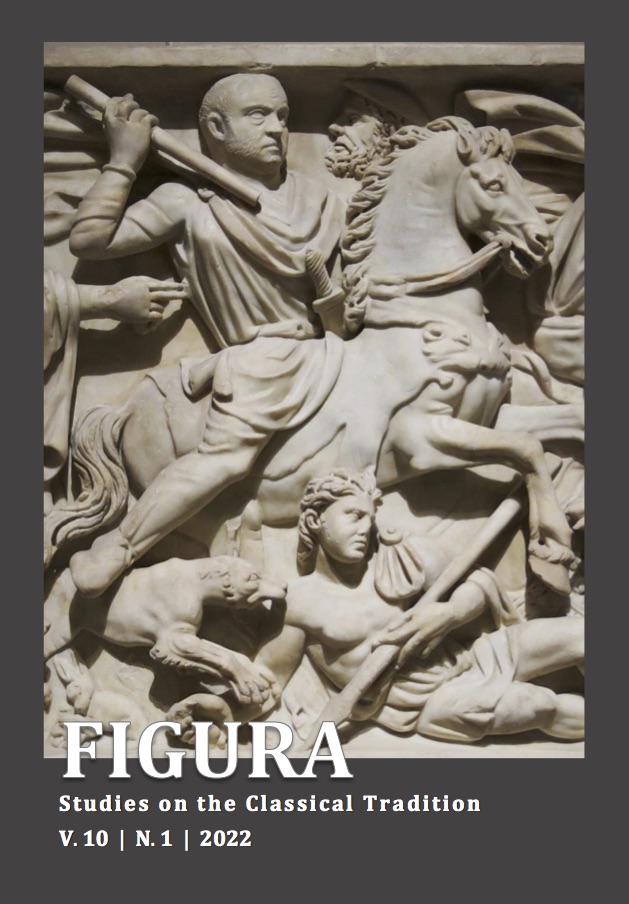Abstract
The article aims to answer the call of the dossier The Classic and its Appropriations in the Christian Tradition through the notion of pathosformel of mourning, derived from the thought of Aby Warburg. In philological logic, the literary and visual sources of the pathosformel of mourning are articulated in Renaissance works reproduced in the Atlas Mnemosyne. The theatre of mourning appears here in a funerary urn and an ancient sarcophagus, which together with The Bacchae of Euripides, provide the link of the ancient with the themes of mourning under the cross, the deposition and burial of Christ in the Renaissance works of Donatello, Bertoldo di Giovanni and Giorgio Vasari, added to the bourgeois funeral lamentation in a relief of Andrea del Verrochio. As a conclusion, we see the spectrum of the expression of funeral lamentation in the art of the Renaissance, also noting the process of energetic inversion in which the maenads in orgiastic abandonment in pagan tragedy become Christian dolents. The study of the images reveals, finally, the power of the expressive formula to manifest the experiences of human commotion.
References
AGAMBEN, Giorgio. Ninfas. Coleção Bienal. São Paulo: Hedra, 2012.
ALBERTI, L. B. Da pintura. Campinas, SP: Editora da Unicamp, 2014.
BORDIGNON, Giulia. “L’Espressione antitética in Aby Warburg: la polarità semantica dei gesti dalle Pathosformeln all’ arte del Rinascimento”. Engramma, n. 32, ap. 2004. Disponível em: http://www.engramma.it/eOS/index.php?id_articolo=2675 Acesso em: 14/01/2022.
DERRIDA, Jacques. Mal de Arquivo: uma impressão freudiana. Relume-Dumara, 2001.
DIDI-HUBERMAN, Georges. Imagens apesar de tudo. Tradução de Vanessa Brito e João Pedro Cachopo. Lisboa: KKYM, 2012.
DIDI-HUBERMAN, Georges. Ninfa dolorosa: Ensayo sobre la memoria de um gesto. Valencia: Ediciones Shangrila, 2021.
EURÍPEDES. As bacantes. São Paulo: Hedra, 2010.
FERNANDES, Cássio. “Introdução: Sobre uma conferência autobiográfica de Aby Warburg”. In: WARBURG, Aby. A presença do antigo. Campinas: Editora da UNICAMP, 2018. p. 11-34.
FOUCAULT, Michel. A Arqueologia do Saber. Rio de Janeiro: Forense Universitária, 2008.
GINZBURG, Carlo. “Le forbici di Warburg”. In: CATONI, M.L.; GINZBURG, C.; GIULIANI, L.; SETTIS, S. Tre figure: Achille, Meleagro, Cristo. Milano: Feltrinelli, 2013. p. 109-132.
RÉAU, Louis. Iconografia del Arte Cristiano: Iconografia de la Bíblia - Nuevo Testamento, Tomo 1/Vol. 2. Barcelona: Ediciones del Serbal, 1996.
SACCO, Daniela. Ninfa e Gradiva: dalla percezione individuale alla memoria storica sovrapersonale. Cahiers d’Études Italiennes, n. 23, p. 45-60, 2016.
SEMINARIO di MNEMOSYNE, “Il teatro della morte: saggio interpretativo di Mnemosyne Atlas, Tavola 42”. Engramma, n. 2, ottobre 2000. Disponível em: http://www.engramma.it/eOS/index.php?id_articolo=2637. Acesso em: 19 jun. 2021.
SETTIS, Salvatore. “Ars moriendi: Cristo e Meleagro”. In: CATONI, M.L.; GINZBURG, C.; GIULIANI, L.; SETTIS, S. Tre figure: Achille, Meleagro, Cristo. Milano: Feltrinelli, 2013. p. 83-108.
WARBURG, A.; BING, G. Diario Romano (1928-1929). Madrid: Siruela, 2016.
WARBURG, Aby. Atlas Mnemosyne. Paris: L’Ecarquillé, 2012.
WARBURG, Aby. “O nascimento de Vênus e A Primavera de Sandro Botticelli: uma investigação sobre as representações da Antiguidade no início do Renascimento italiano (1893)”. In: WARBURG, Aby A Renovação da Antiguidade pagã: Contribuições científico-culturais para a história do Renascimento europeu. Rio de Janeiro: Contraponto, 2013. p. 3-88.
WARBURG, Aby. “Dürer e a Antiguidade italiana (1905)”. In: WARBURG, A. A Renovação da Antiguidade Pagã. Rio de Janeiro: Contraponto, 2013. p. 435-445.
WARBURG, Aby. “De arsenal a laboratório”. In: WARBURG, Aby. A presença do antigo. Campinas: Editora da UNICAMP, 2018. p. 37-52. p. 48.
WARBURG, Aby. “O ingresso do estilo ideal antiquizante na pintura do primeiro Renascimento (1914)”. In: WARBURG, Aby. A presença do antigo. Campinas: UNICAMP, 2018. p. 91-140.
WARBURG, Aby. “Mnemosyne. O Atlas das imagens. Introdução”. In: WARBURG, Aby. A presença do antigo. Campinas: Editora da UNICAMP, 2018. p. 217-230. p. 219-220.
WEDEKIN, L. M.; MAKOWIECKY, S. “Prancha 25 do Atlas Mnemosyne e Agostino di Duccio: Apolíneo e Dionisíaco no Oratório de São Bernardino em Perugia”. MODOS: Revista de História da Arte, Campinas, SP, v. 4, n. 3, p. 146–175, 2020. DOI: 10.24978/mod.v4i3.4569. Disponível em: https://periodicos.sbu.unicamp.br/ojs/index.php/mod/article/view/8662708. Acesso em: 29 jun. 2021.
WIND, Edgar; ANTAL, Frederik. “La Menade sotto la Croce (1937)”. Engramma, n. 132, gen. 2016. Disponível em: http://www.engramma.it/eOS/index.php?id_articolo=2712. Acesso em: 14/01/2022.
WINCKELMANN, J.J. Reflexões sobre a arte antiga. Porto Alegre: Movimento, 1975.

This work is licensed under a Creative Commons Attribution-NoDerivatives 4.0 International License.
Copyright (c) 2022 Luana Maribele Wedekin, Sandra Makowiecky

